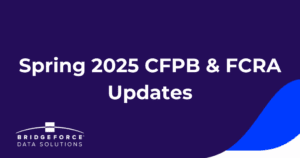On November 6th of this year, the Court of Appeals for the Eleventh Circuit overturned a lower court’s ruling. It made clear that the Fair Credit Reporting Act does not require individuals to demonstrate proof of actual damages to recover statutory damages. You can read the full story here and view the full court opinion here.
Bridgeforce Data Solutions CEO Matt Scarborough provided his thoughts on the impact this could have on the industry moving forward:
I am not an attorney, but this court action jumped out at me. It involves a class action lawsuit against Experian, and it is a powerful reminder that under the FCRA, there can be significant liabilities without the need for the consumer to prove actual damages. We frequently see the sorts of issues highlighted in this case in the Metro 2® and ACDV Data that we inspect for our clients, so the potential liabilities across the industry require actions from all stakeholders to mitigate.
In this case, according to the 11th Circuit’s opinion, more than 2.1 million consumers had credit reports with inaccurate status dates, and those consumers may be entitled by statute to “damages of not less than $100 and not more than $1,000” each without any need to prove actual damages. This results in a potential liability of $210 million to $2.1 billion in this case. The lower court had dismissed it for lack of actual damages, but the appeals court vacated that decision and remanded the case back to the lower court to sort this out.
This case will continue to be litigated and hinge upon whether the errors were a willful violation of the FCRA. As a reminder of the odd language in the statute, it requires the defendant to have “reasonable procedures” for “maximum possible accuracy.” In this case, the inaccuracy persisted for about 18 months, according to the court opinion, so it seems to me that the attorneys for both sides will be arguing about whether procedures and controls that failed to detect the issues are a willful violation of the duty to have “reasonable procedures” for “maximum possible accuracy.”
So, on balance, here is the bad news and good news for the industry as I see it:
The bad news:
- With potential damages arising at a rate of $100-1000 per record, even without any actual damages, the potential damages are significant
- These potential damages are incremental to any regulatory actions – this is just from the civil lawsuits
The good news
- If you have strong controls in place to detect issues and then take corrective action on what you find, then your risk from something like this class action should be low
- Automated compliance solutions like our Data Quality Scanner (DQS) can help you easily find data issues that could cause FCRA civil lawsuit liabilities and regulatory risks, and they can be leveraged quickly
We continually monitor events like this as part of keeping our rulesets up to date, so we’ll post again once we see how this case completes.



